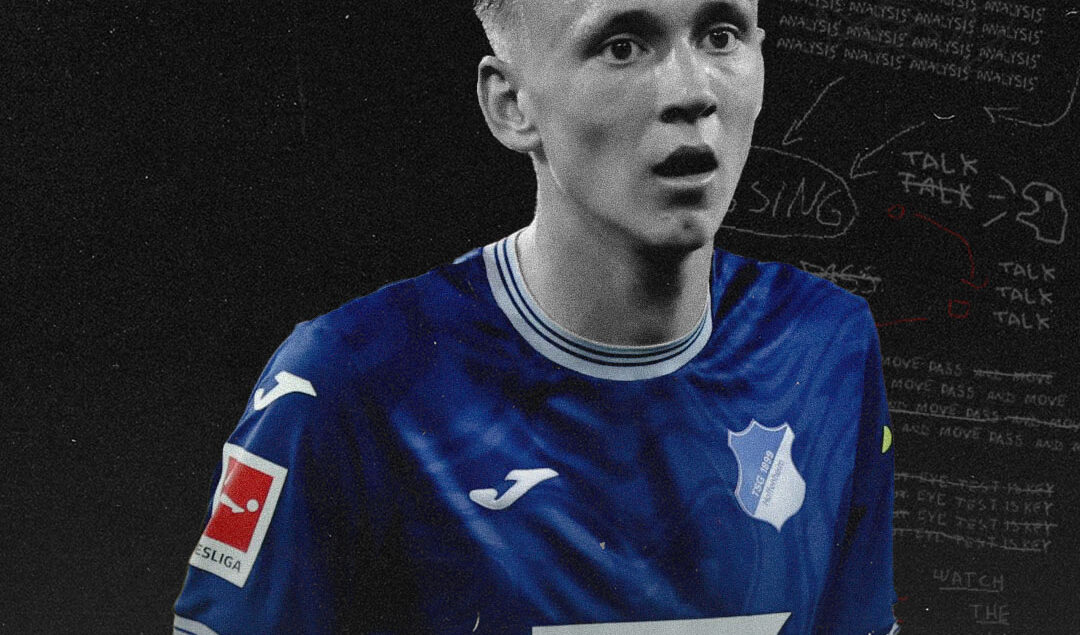Maximilian Beier: Hoffenheim’s Next Top Talent
Germany have been crying out for a world-class center forward ever since Miroslav Klose’s retirement, but they may just have the answer to their predicament in Maximilian Beier. At 21 years of age, Beier is making a name for himself in the Bundesliga this season, having racked up 13 goals and 4 assists in 31 appearances this season for Hoffenheim — only Harry Kane, Serhou Guirassy, Loïs Openda, Deniz Undav and Ermedin Demirović have scored more in the top-flight.
Hoffenheim look set to finish inside the top eight for the first time since 2019/20 with Die Kraichgauer currently sitting eighth in the Bundesliga, two points behind Freiburg and one above Augsburg, Heidenheim, and Werder Bremen, with a game in hand on each of them.
Pellegrino Matazzo’s side will travel to already-relegated Darmstadt, who sit bottom of the table, before closing out their campaign with a home match against Bayern Munich. If they can sneak into the top seven, they’ll qualify for the UEFA Europa Conference League playoff round, and Beier looks set to play a vital role for them as they seek a spot in European competition for next season.
Beier worked his way through to the youth ranks of Energie Cottbus, initially from an academy in a small town in Germany; Brandenburger SC Süd 05. He earned a move to Hoffenheim in 2018, departing Brandenburg for Sinsheim. By the end of the 2018/19 campaign, the Brandenburg native was already displaying his immense goalscoring abilities, finishing as the local South/Southwest division top scorer with 18 goals.
A season after, which was the 19/20 season Maximilian Beier wore his record breaking suit as that would kickstart his professional journey. On February 8, Maximilian Beier made his professional debut with TSG Hoffenheim against Freiburg becoming Hoffenheim’s youngest-ever Bundesliga debutant at age 17 and breaking the record previously set by Borussia Dortmund defender Niklas Süle.
Beier secured his first professional contract in time for the 2020/21 season and was entrusted with a squad player role and limited minutes, but he would increase his stock with a brace in their UEFA Europa League match vs. Gent. However, rather than give him increased minutes in the first-team, the Hoffenheim executives decided he needed consistent minutes to refine his game and sent him out on loan to second-tier side Hannover.
He would spent two seasons at the Heinz von Heiden-Arena, scoring 15 goals and 7 assists in 68 matches with Die Roten and earning himself a new contract. “Above all, it is important for him to even get into positions from which he can shoot. He can manage that thanks to his dynamism and technique. You either have those genes or you don’t, and Maxi has those genes to score goals.” – TSG boss Pellegrino Matarazzo on Beier.
Rafiu Adekunle Durosinmi: The Nigerian Striker Primed for a Big Move
Since returning to Hoffenheim this summer, Beier has enjoyed a stellar campaign in the top-flight. After coming off the bench for the final minutes of their season opener, Beier was inserted into the XI and rewarded the manager’s trust by scoring in four matches in a row.
He would rack up an impressive 6 goals and 3 assists in the next 9 matches, whilst he would also score back-to-back braces in victories against Borussia Dortmund and Werder Bremen in February and March. This would see him earn the Bundesliga Rookie of the Month award for February.
Player Profile
‘Maxi’ stands at 6’0ft, a distinct height in the game of football, which in the same breath is a rarity in today’s game seeing a winger/striker hybrid player that tall (common for 9s). Beier has an agile frame with a longer legs-body ratio. He recognizes this and uses it well in different ways, with and against the ball.
An example is his powerful running style in the final third, as he compacts his legs to the ground for nimble movements in little spaces and also makes use of his long legs for higher strides when he carries through a long distance. Against the ball, he often ghosts into challenges, cutting passing lanes by extending the range of his legs fully to intercept passes.
“I played against him in my first years as FC Bayern’s U17 coach and his qualities were immediately apparent. He runs an incredible amount, works for the team and rewards himself with goals. I’m sure Julian Nagelsmann has him on his radar” -Miroslav Klose.
Playing Position
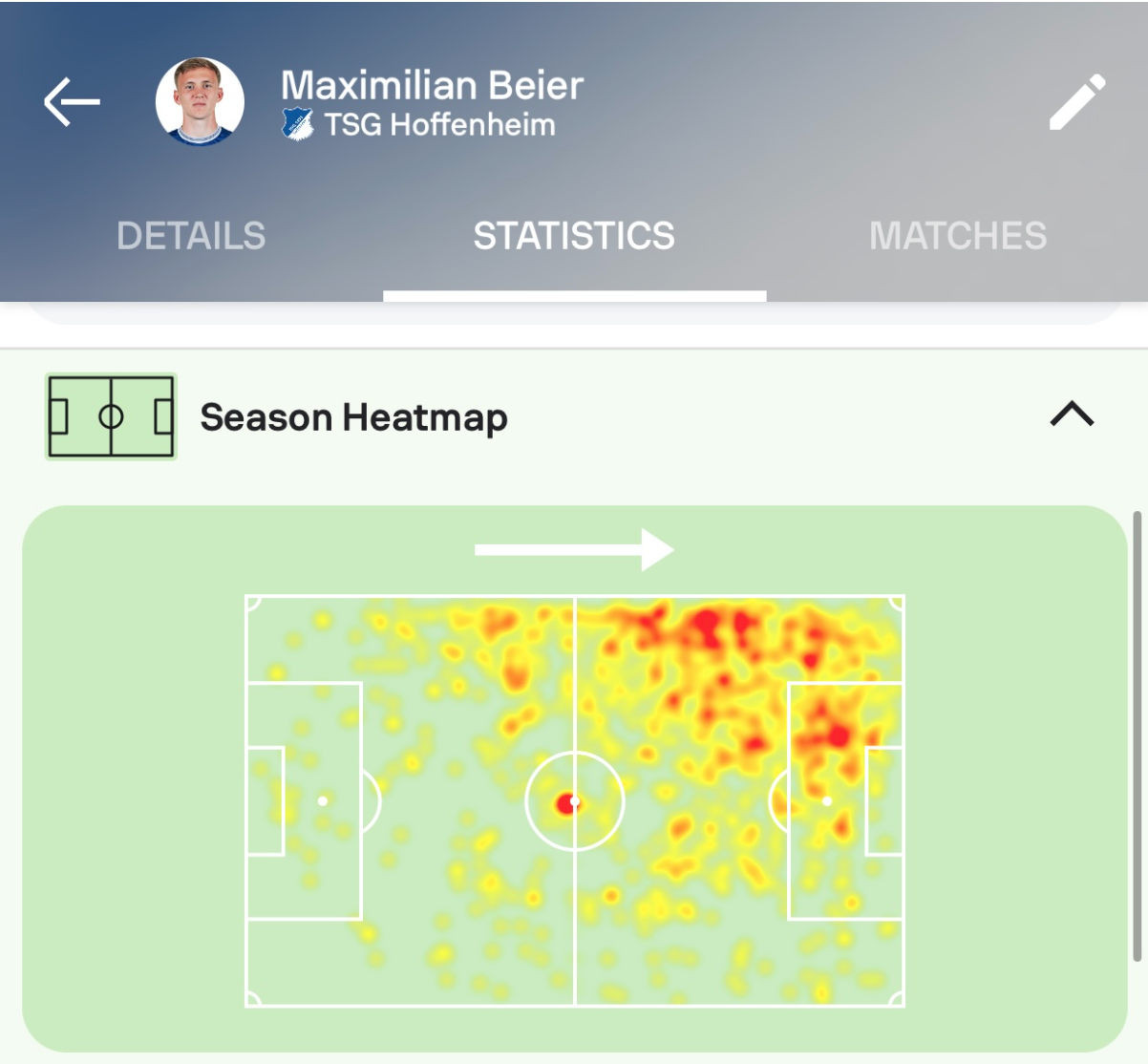
Photo: Sofascore
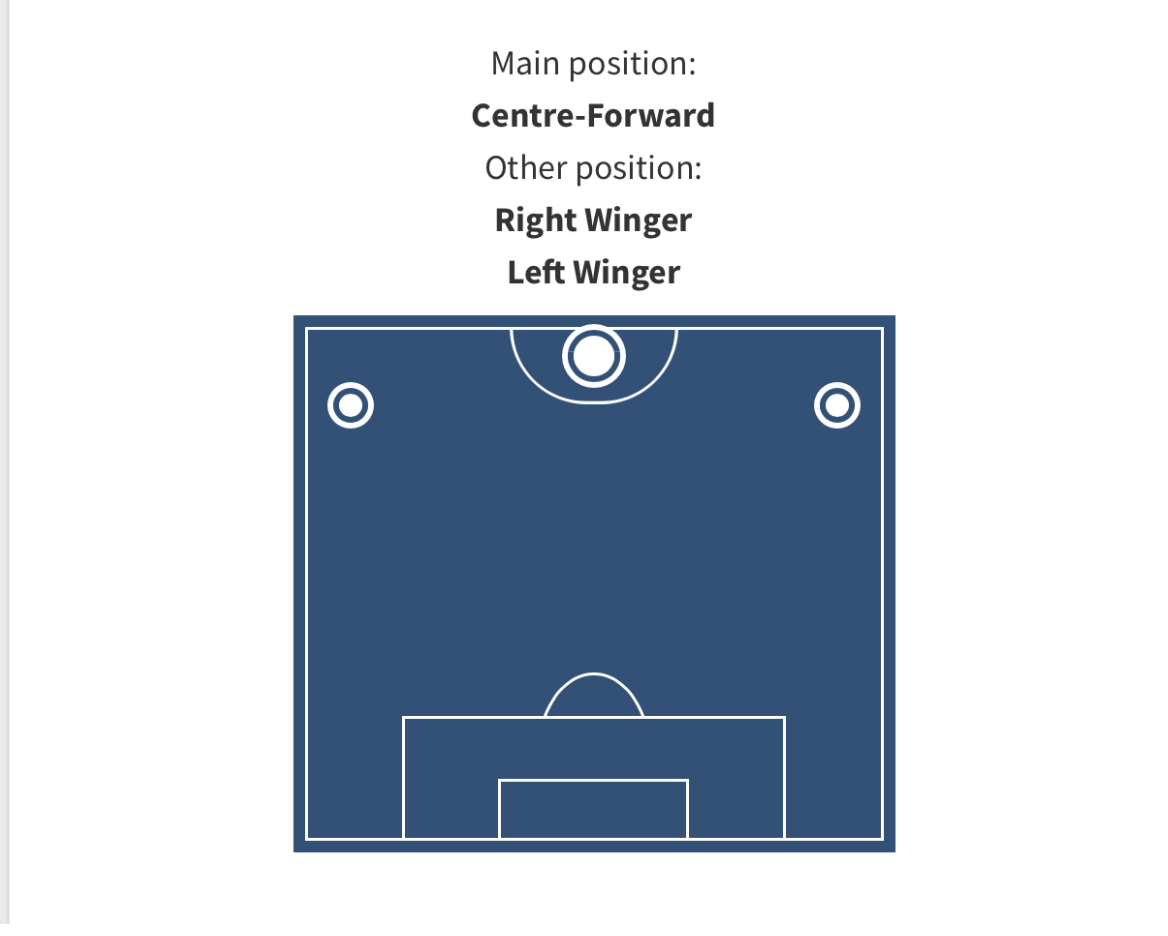
Photo: Transfermarkt
Beier has featured in eight different formations for TSG Hoffenheim this season with most coming in a 3-5-2 / 5-3-2 (off the ball), forming a strike partnership with ex Manchester United man Wout Weghorst, who joined on loan from Burnley last summer.
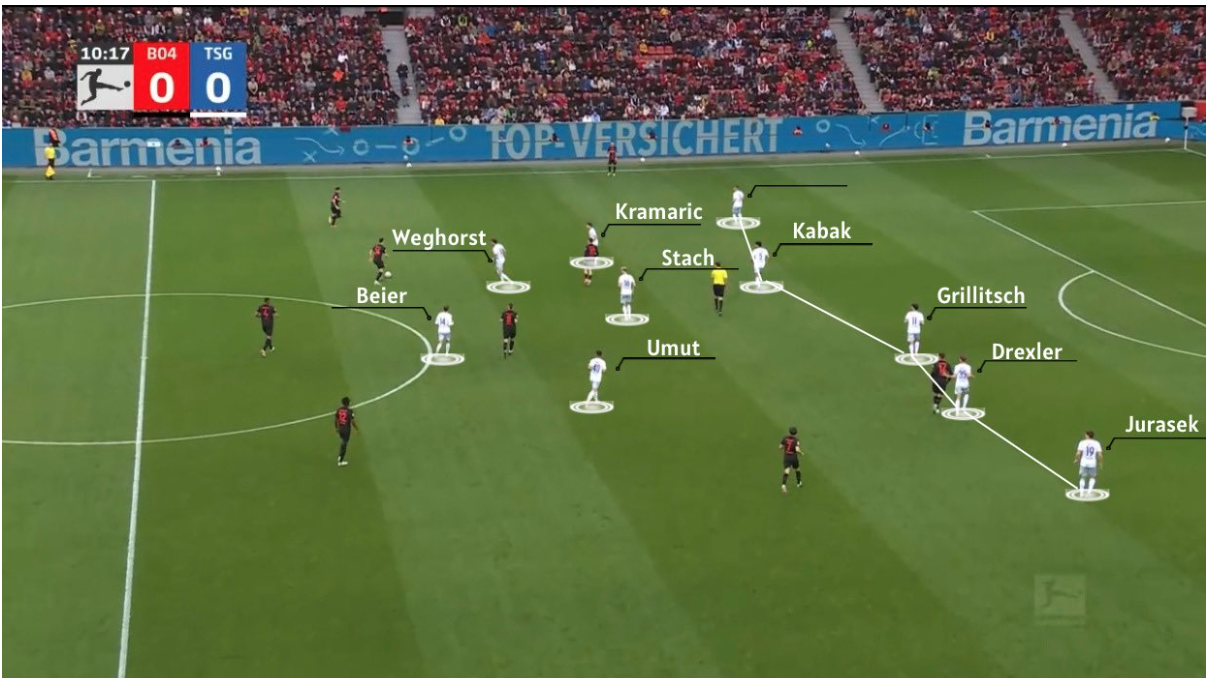
In this formation, he has multiple roles depending on the type of opponent. In rare cases, he’s been a focal point of attack when the game plan is to play direct & long where he’s utilised in winning first balls & playing with his back to goal. In most cases, Wout Weghorst takes up that role while ‘Maxi’ Beier takes up the second striker role & makes his starting positions high up on the left where he roams deeper and wider to allow Hoffenheim have more players in the box and also attack the space between the right centre back and fullback.
Technical Analysis
Maximilian Beier is a right-footed attacker (adept at also using his left foot brilliantly) who raises the attacking threat of his team with a variety of actions across the front line. As a player, his play is all about calculated timings, he knows when to make forward runs before the play is made, when to penetrate the box, when to carry over a long distance and when to overload/hug a flank. These on & off-ball qualities make him a quality player against defences even when he’s not scoring goals unlike other service-reliant strikers (he plays with one). Let’s dissect his play in different variations.
Timing, Anticipation and Angles of Forward Runs
Beier’s play is all about calculated movements, all about space exploitation, all about running at defenses. The combination of the understanding of game rhythm and spatial awareness enables him to create quick reaction time ahead of others & get to the ball before them.
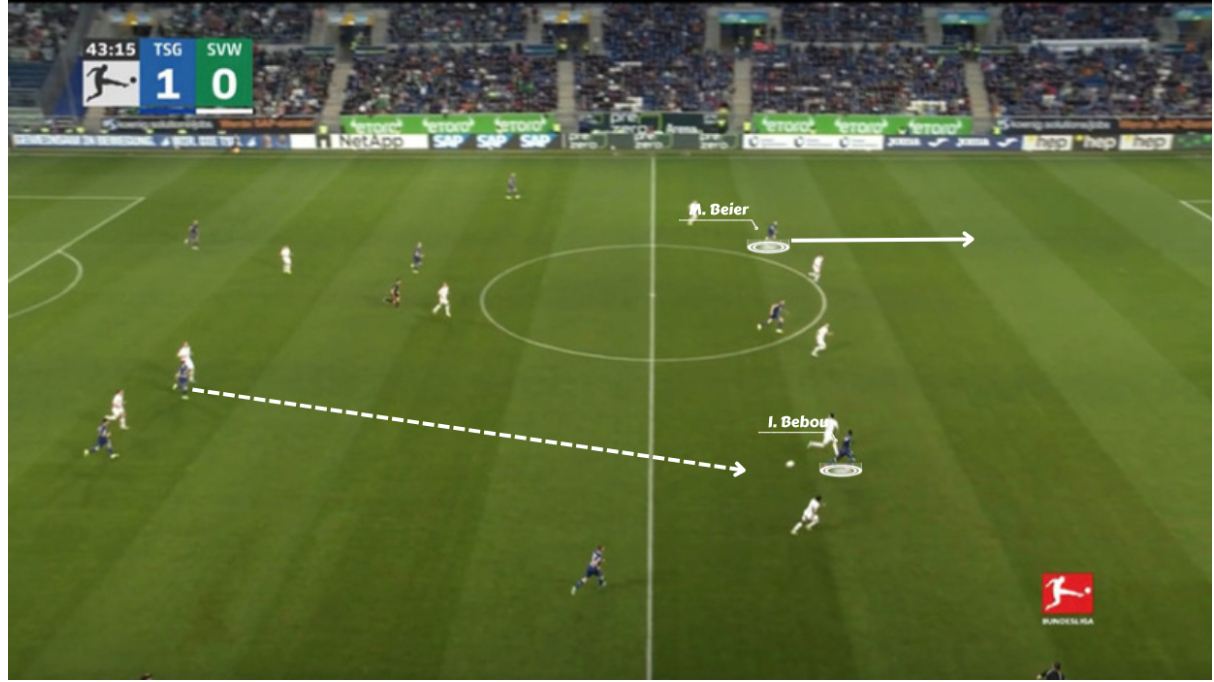
In this image image, once the ball is recovered in Hoffenheim’s half, the centre defender plays a quick forward pass to Ihlas Bebou (Maximilian Beier already predicted the play before the ball got to him & already started to make the run forward).
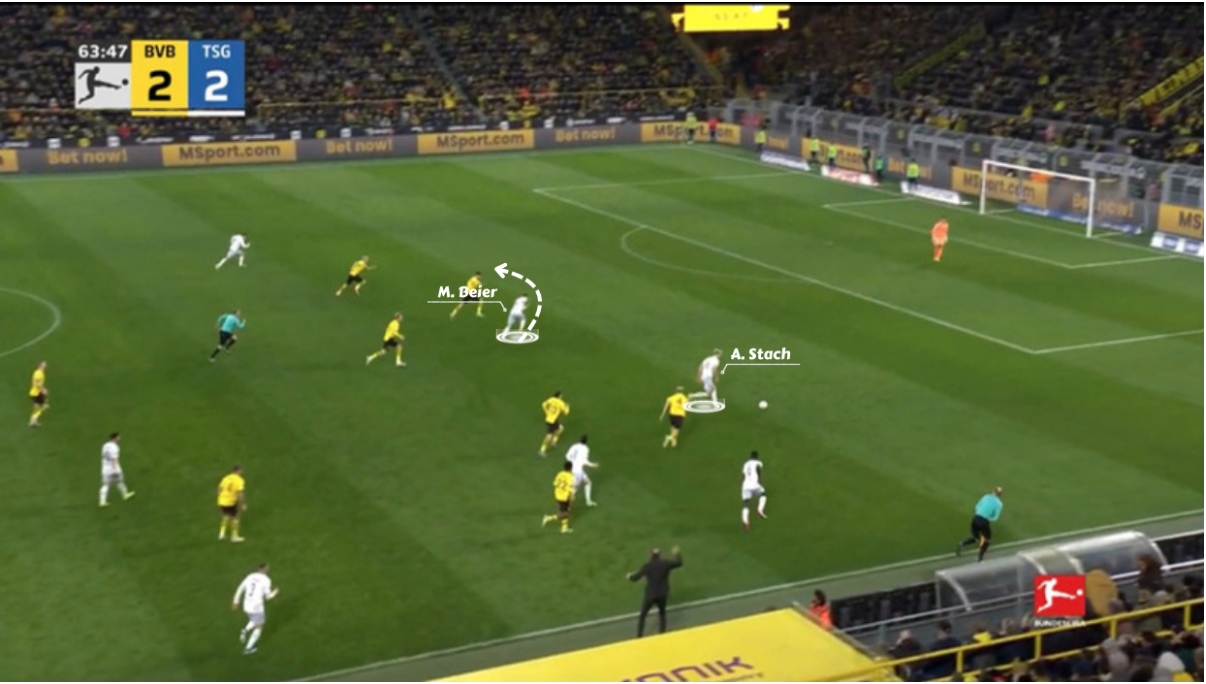
In this image (above), Anton Stach receives a through ball on goal to attack the box, and Maximilian Beier recognizes a gap between Dortmund defenders & makes a timely curved run into it by adjusting his movement to create an angle to receive the cutback.
Movement with Ball to Create Space & Long Distance Runs
Maximilian Beier is already turning a master at creating space with movement (runs & dribbles) with the ball, manipulating angles and defenders by constantly shifting his body weight, and utilizing quick touches and change of pace to arrive into his favourable areas and create shooting and passing opportunities for himself/teammates.
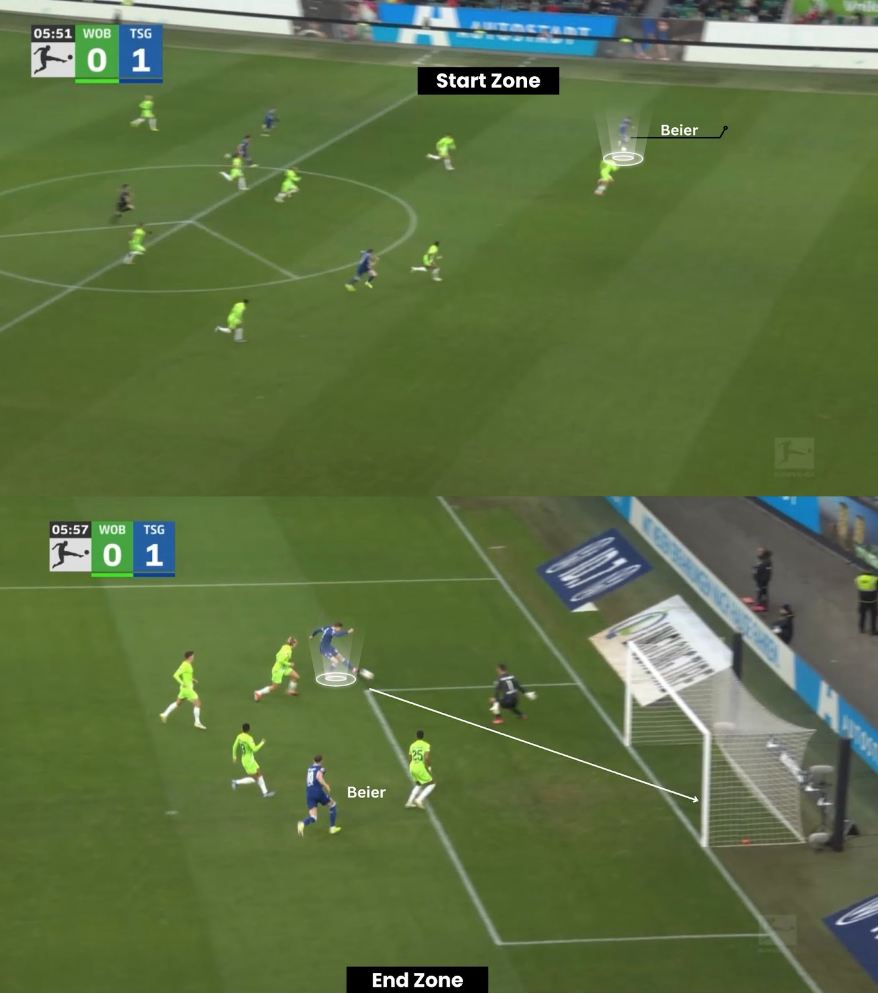
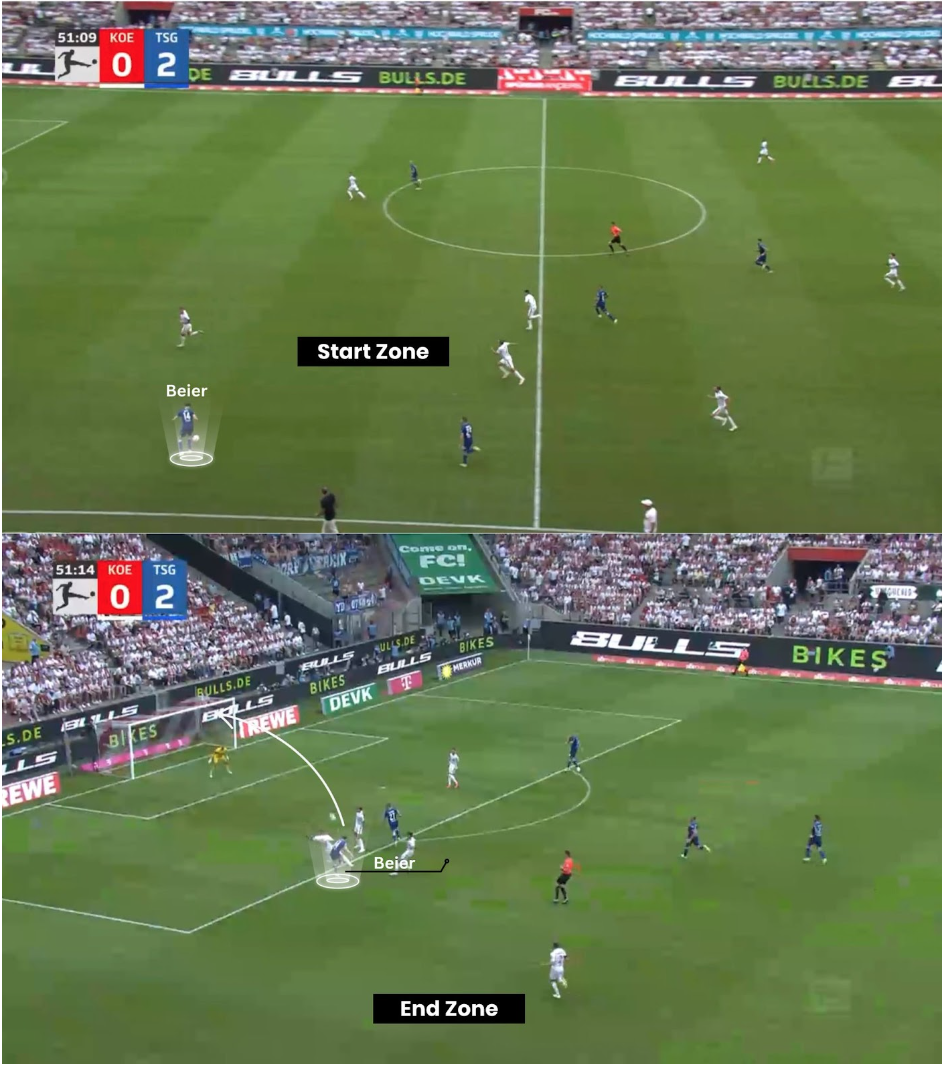
The images above captures his orientation when it comes to positioning and also how comfortable he is receiving at any distance, driving and stretching defences with pace, as well as how expansive his finishing can get. He’s one of the best pure ball-strikers in the league, and even in awkward angles, he finds his finishes. In other words, he turns nothing into chances or goals.
Composure and Box Finishes
Perhaps his best and most iconic goal so far in the league was against Bayer Leverkusen, not necessarily the quality of goal (quality) is top but rather the quality of the opponent. The goal was brilliantly worked by the team, from the initial 5-3-2 shape against the ball to a 3-4-3 during counters for options around the pitch.
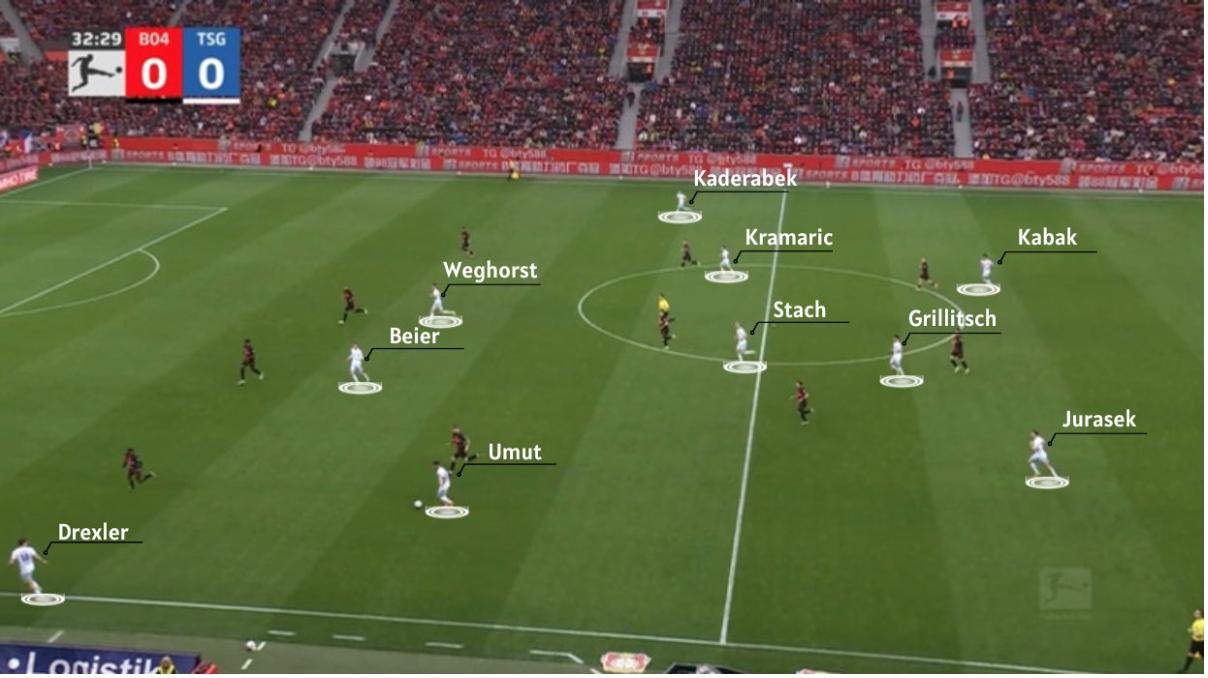
The image above shows the shape they take during counters with Umut Tohumcu allowed to leave the structure by carrying out and connecting the ball with the option(s) on the wide left side, a back 3 with wide spacing, a narrow double pivot and players who are tasked with maintaining the width.
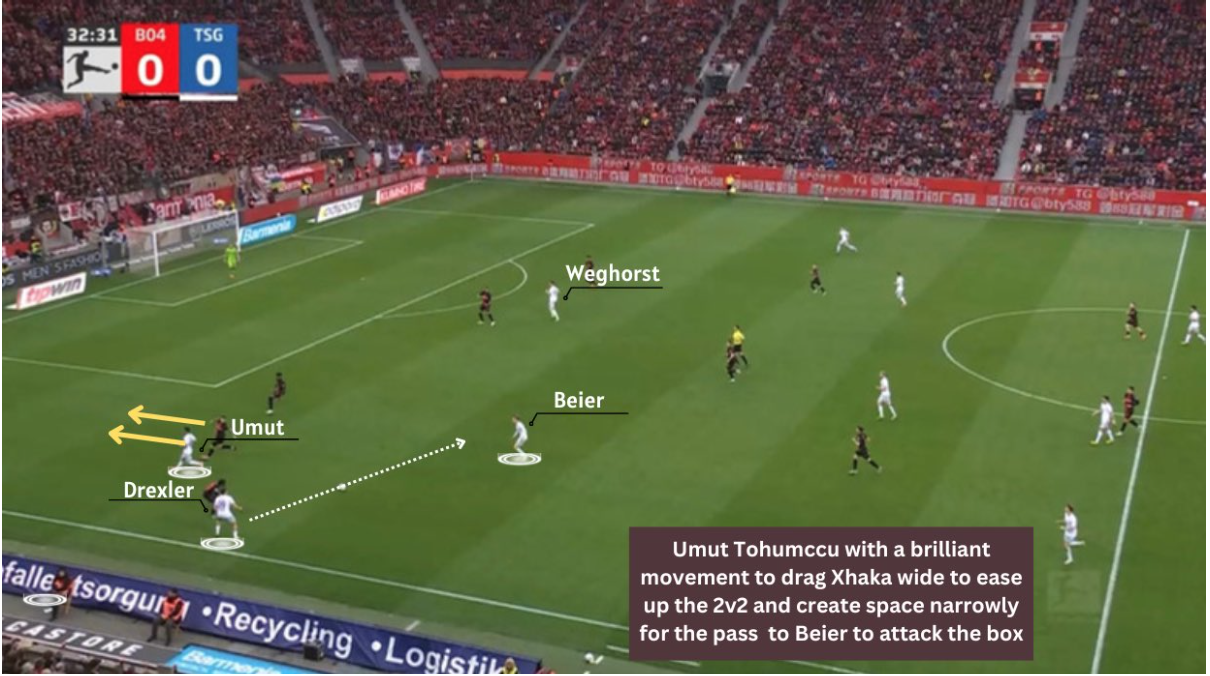
The above image shows the brilliance Umut applied, as he lays off the pass to Tim Drexler but continued to make a disguised run to drag Robert Andrich with him in order to create a clear passing angle inside the field to Beier (who’s situated in the left half space), with Weghorst in between the Leverkusen CBs.
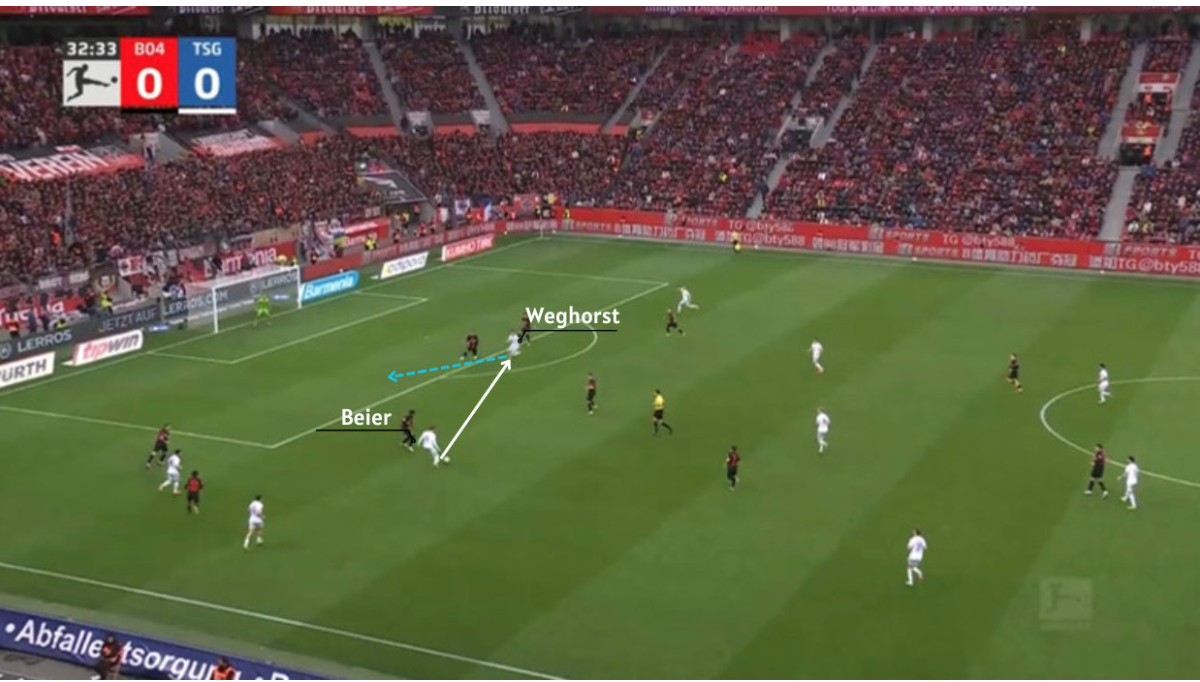
The third move of the sequence is Maximilian Beier showcasing his link-up & short game knowledge. A pass with his weaker foot so his body positioning allows for quick movement to receive the return pass from Wout Weghorst.
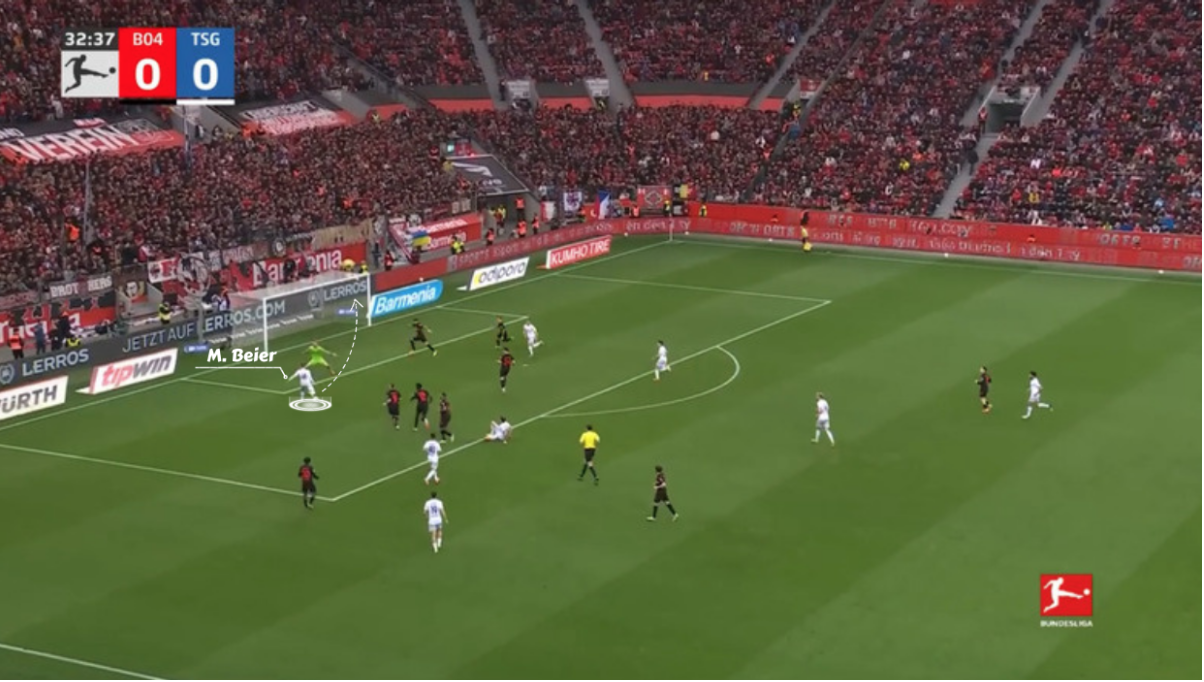
In the last move to crown the sequence, Maximilian Beier makes the penalty box entry after receiving the return pass. This finish is brilliant because the way he opens up the body is elite, in every sense of the word. Under pressure, against one of the best keepers in the league, it doesn’t matter — he gets the job done.
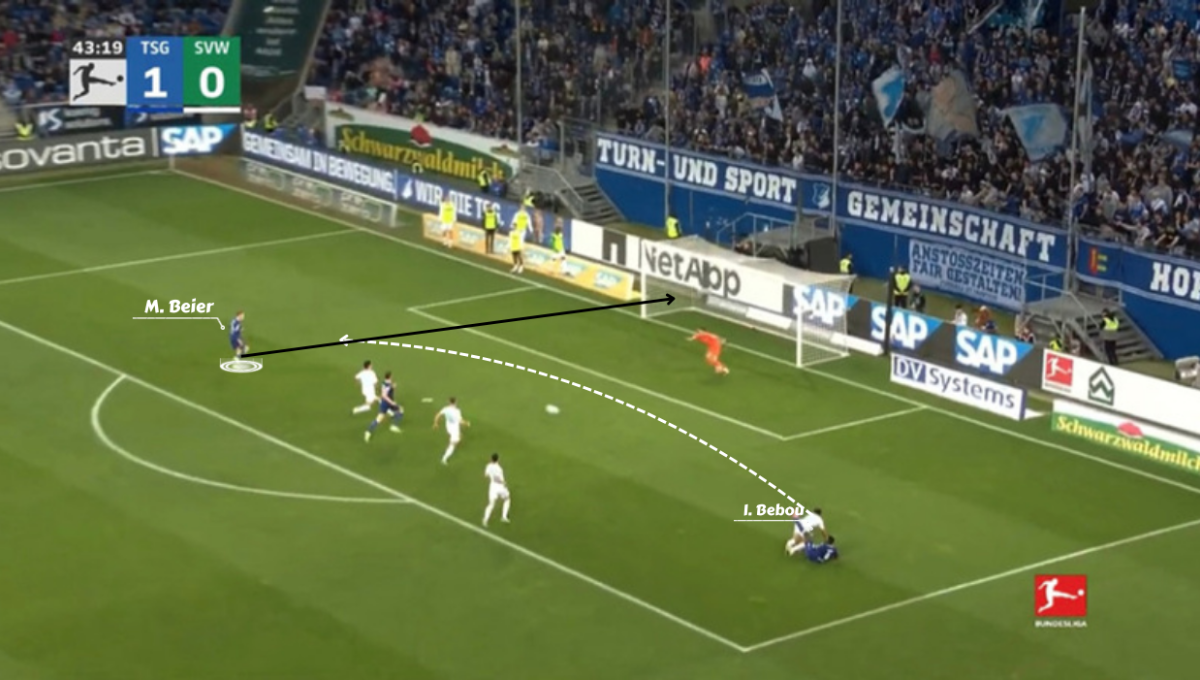
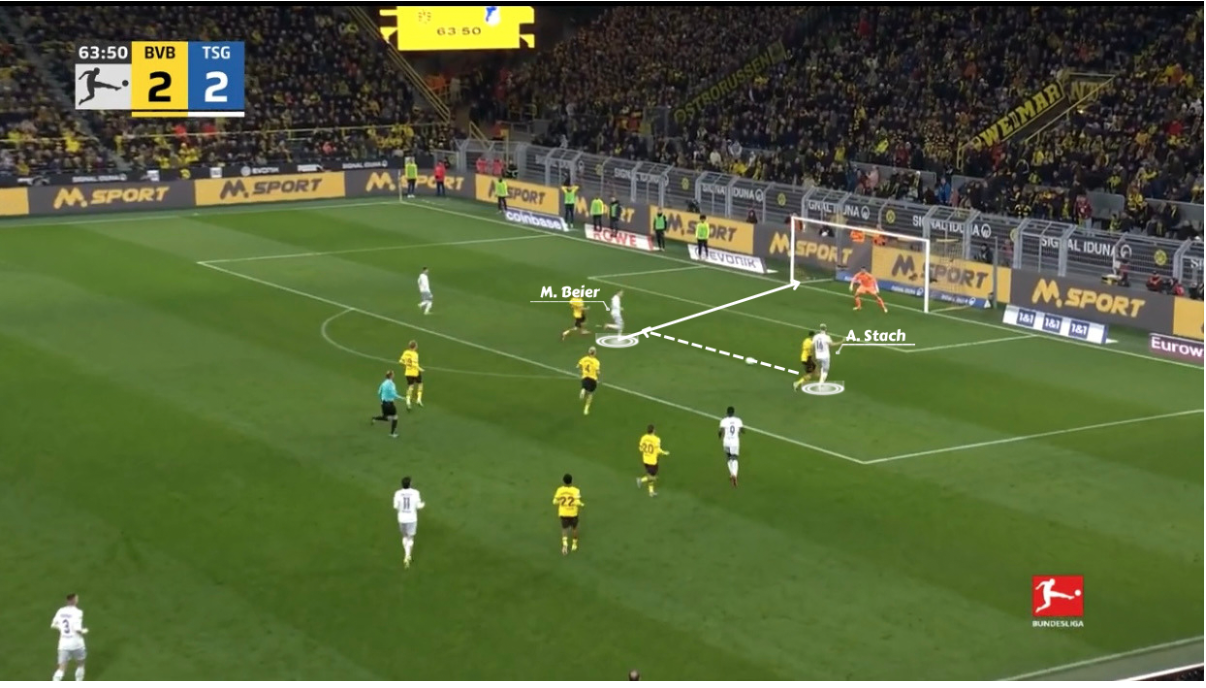
The images above (vs Borussia Dortmund & Werder Bremen) show his composure inside the box from different angles to create his finishes. Undoubtedly, he’s showing he has tendencies of being a big game player which would be one of the key differences in quality to his counterparts.
Work Rate & Receiving Direct Balls
One aspect of Maximilian Beier’s game that needs improvement is the frequency at which he presses off the ball especially in farther zones. He does, but it isn’t enough. For someone who has his kind of legs, pace & ability to extend his presence rapidly he could be a counter-pressing machine.
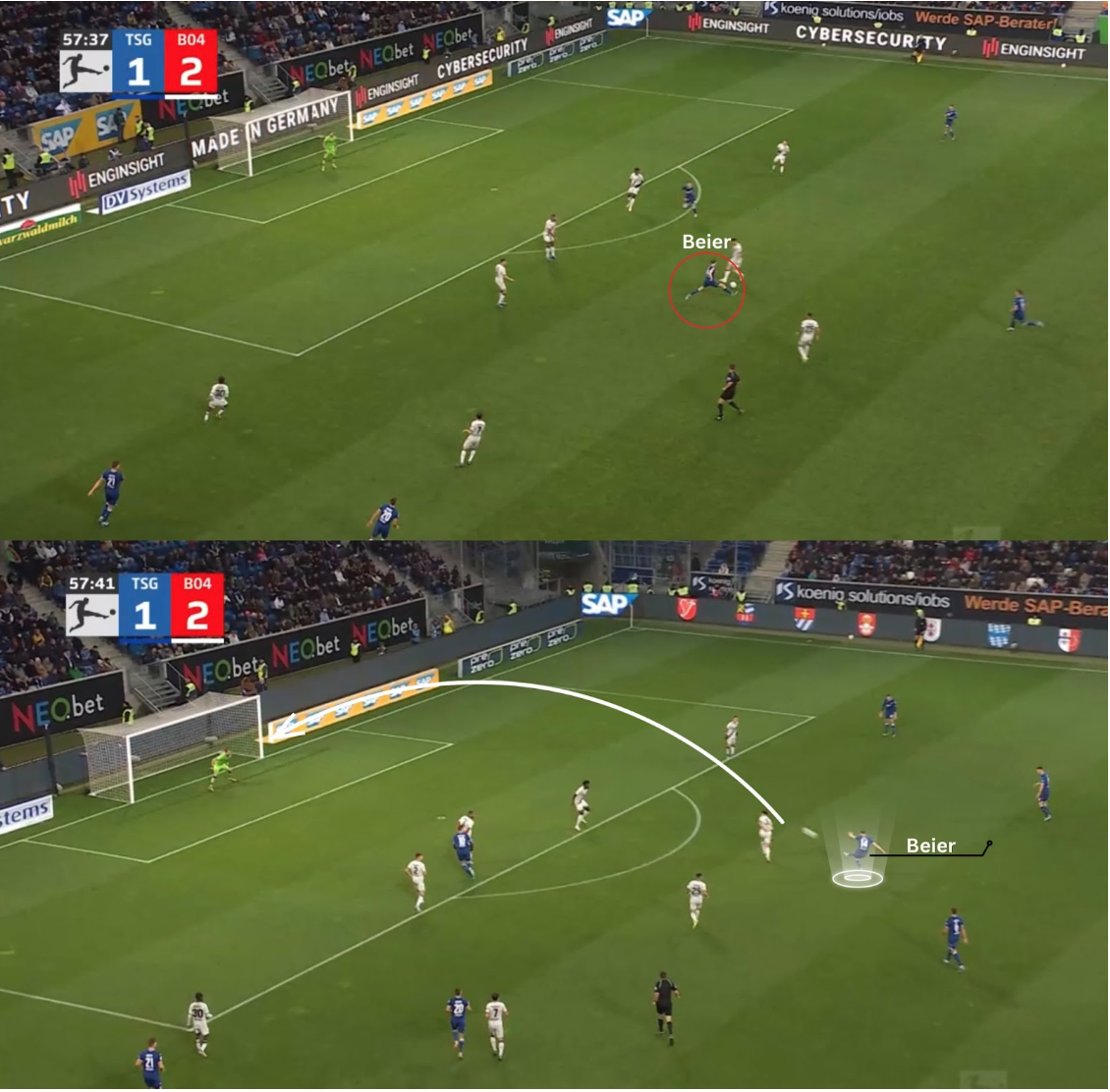
One example is against Leverkusen (H), where he had the intelligence to predict where the opposition would pass to & also the legs to act on it. He intercepts it by cutting off the passing lane & strikes the ball almost immediately (hits the post), a valuable action that brings unpredictability & hits the opposition when they’re unsettled.
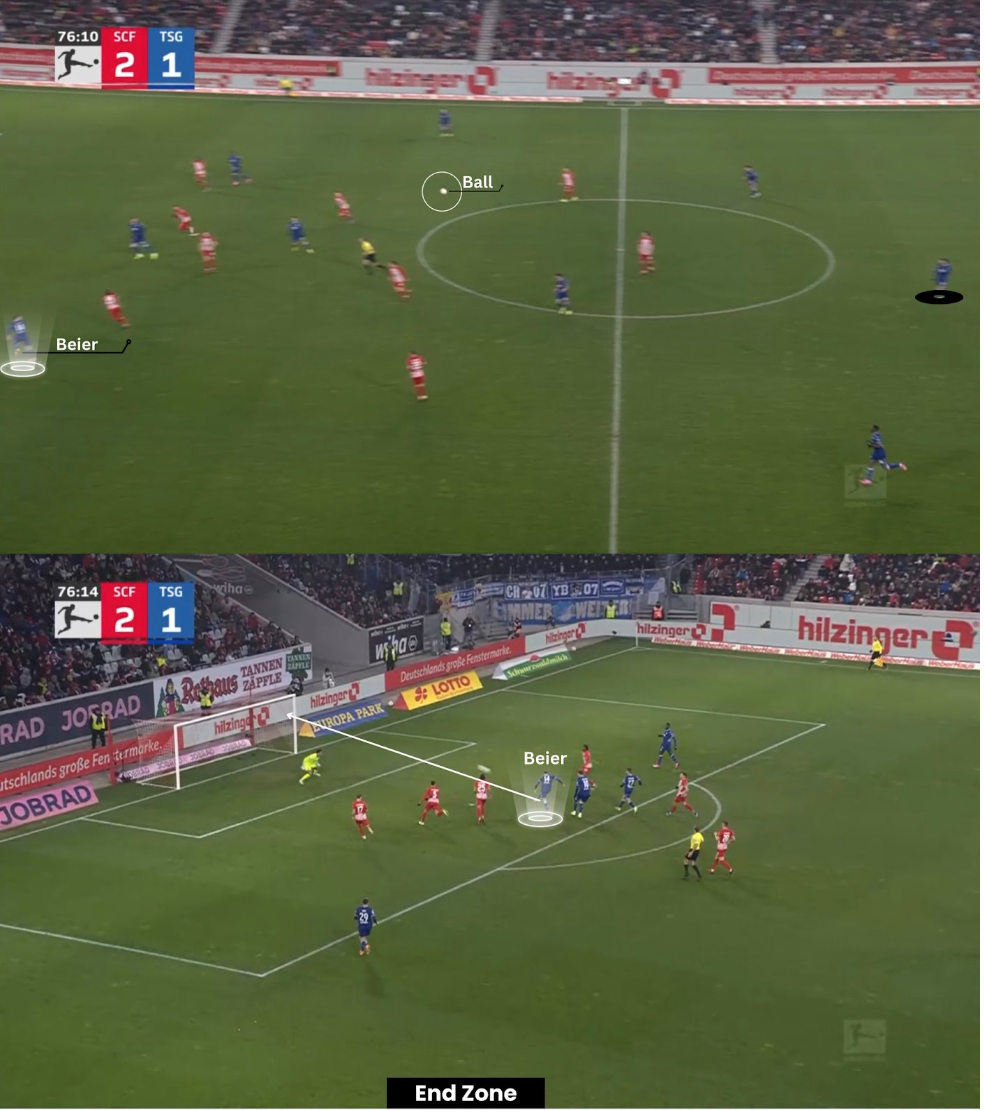
He’s often used as an outlet when the team wants to play long & direct, he’s scored a couple of goals from this. An example is the image above vs Freiburg (A). Positioning in that inside left channel, the CB plays a long ball with Maximilian Beier already on the move, he’s able to get the ball ahead of others & create enough time for the control. He dribbles through & inwardly to arrive at his favourite angle to get the shot away into the net.
Ability to Beat a Man 1v1
Undeniably, this has been touched on at many points in this article but it’s worth putting into another perspective. His 1v1 approach is all about creating angles to arrive in & not just beating his man. As long as he loses his marker to initiate his arrival, he’s satisfied regardless of how he does it. In a Hoffenheim team that’s mostly defending against the ball & with a <50% total possession, he stands out as a different profile in the whole team.
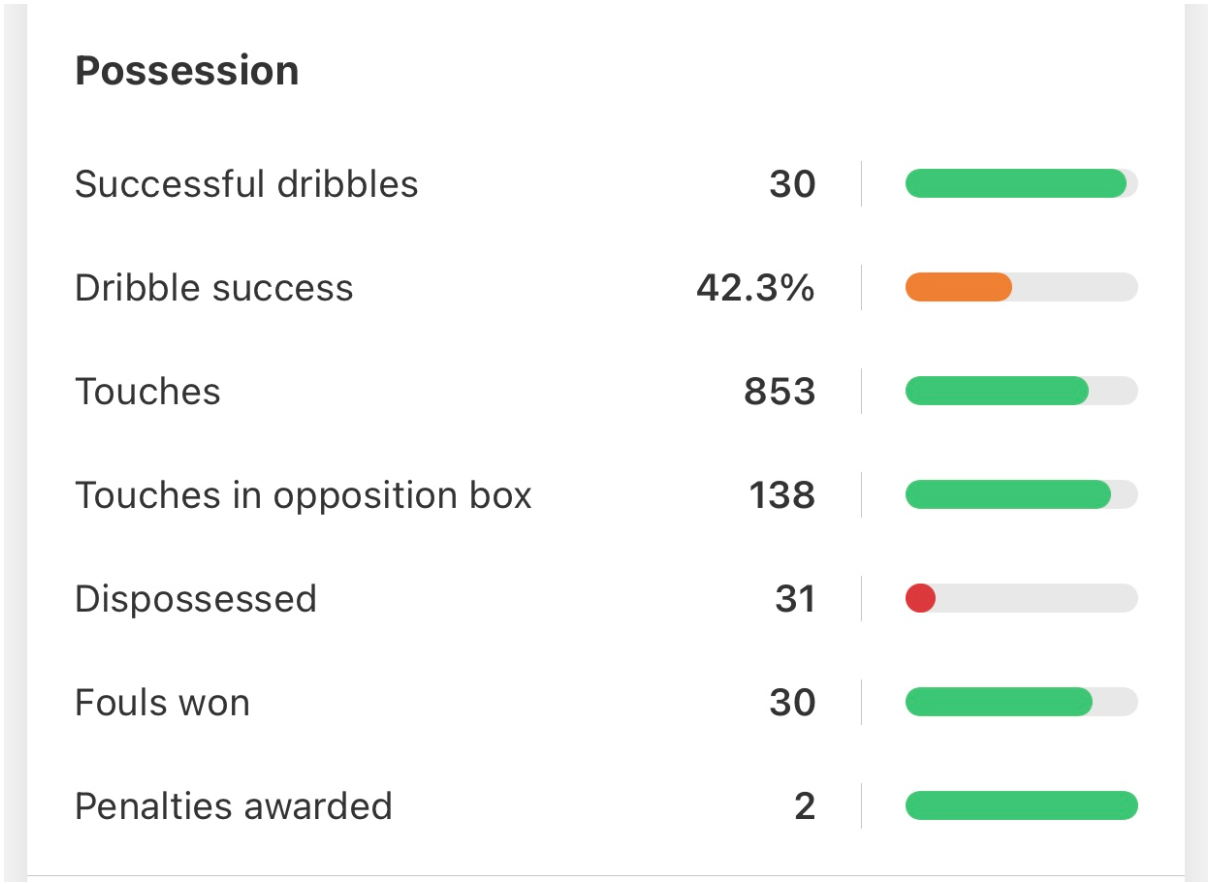
Photo: FotMob
The statistics don’t show the quality of dribbles but it shows he’s in the 96th percentile when it comes to successful dribbles with a low success (%), winning 30 fouls & 2 penalties. He loves making rapid leg movements and allowing the ball to roll at a natural speed, drift into half-spaces / central to either create (not often) or strike the ball.
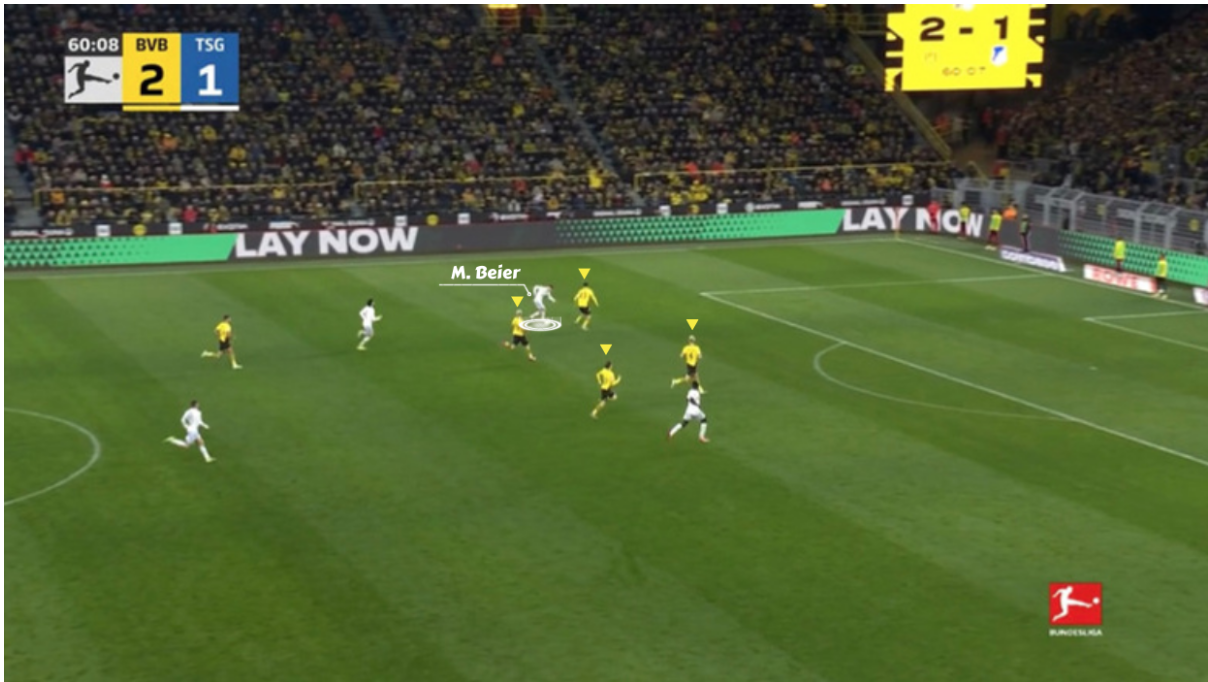
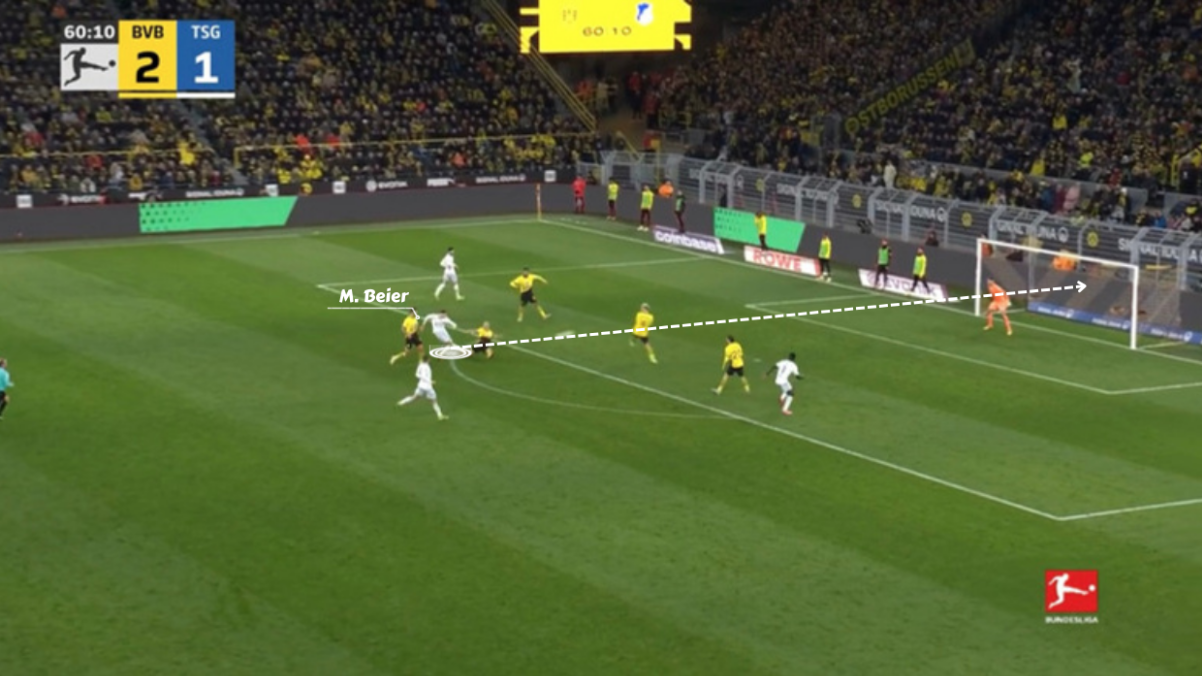
An example is against Dortmund (A) where he scored a brace, his first goal was brilliant. In between a near 2 v 1 and a far side 3/4v1, he chooses to beat his man inside rather than outside to get his shot off. It is a kind of movement that’s hard to mark because in other times this season, he’s able to beat his man on the outside and also get his shots off. This creates a form of indecision in defenders and leaves them wrong-footed.
Finishing with Weaker Foot & Heading Ability
Despite being right-footed, he’s accumulated 3.51xG with his left leg (18 shots, 5 goals) which proves he is two-footed and unpredictable for defenders to read & allows him to exploit openings on either side of the pitch. He’s adept at slotting across any role in the front line, whether by cutting inside on his stronger foot for a clean strike or delivering a variety of passes with his weaker one.
It’s also worth noting that being two-footed also gives him many options when receiving the ball, adjusting his body to control passes from different angles & in most cases leaving opponents wrong-footed.
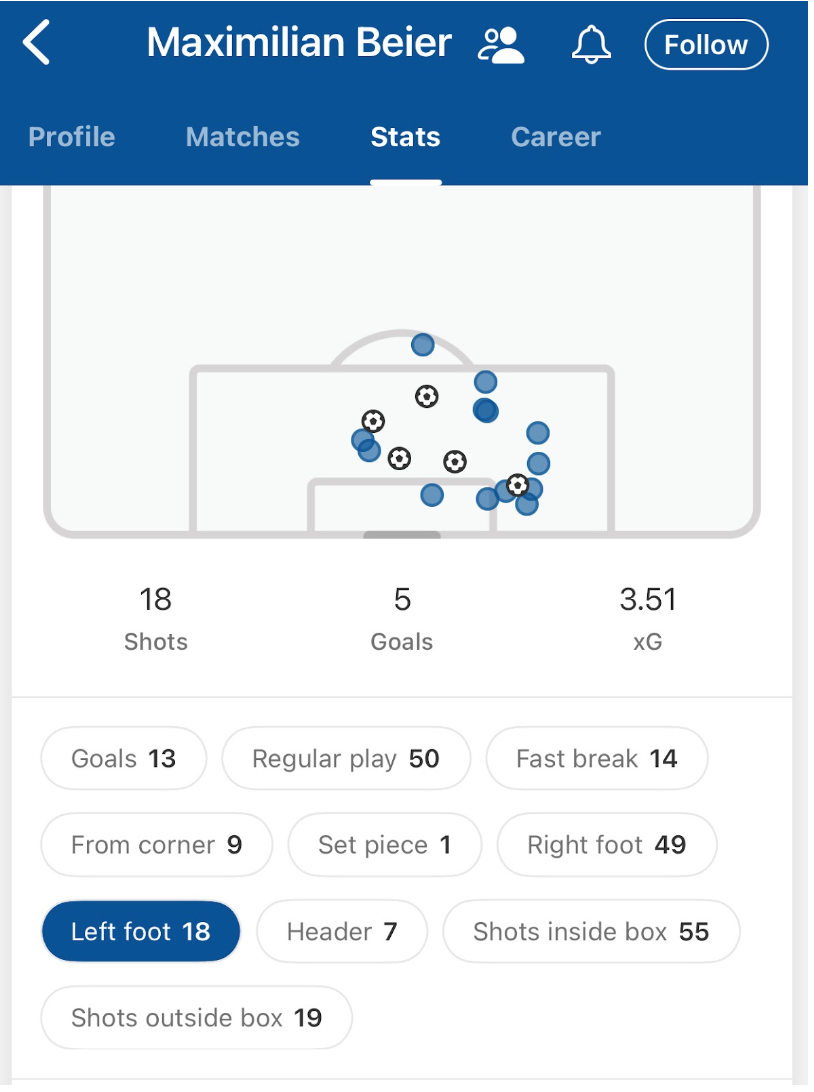
Photo: FotMob
Another aspect of improvement in his game is his aerial proficiency, on and off the ball. He’s only used his head to get a shot off seven times (0.58xG) this season and converting none, winning 35.1% aerial duels along the way.
Although, it is understandable the lack of aerial chances stems largely due to his positioning & how he’s mostly not the focal point of crosses (Wout Weghorst is in charge of this). There are indications that if he joins another team or Weghorst leaves, these numbers shoot up.
Conclusion
At 21 years of age, Maximilian Beier is becoming an attacking talisman for Hoffenheim, taking on a large share of responsibility, being a team player, and most importantly enjoying himself while doing it. With a contract until 2027, it may only be a matter of time before he departs the Rhein-Neckar-Arena for one of the biggest clubs in Europe.
He has the potential to become one of the best strikers generation, lead his team to multiple championships/titles and emerge as an influential figure for his country, a formidable attacking threat in settled build-up play as well as transitional opportunities. Moreover, if Germany manager Julian Nagelsmann does call him up for the forthcoming European Championships, this could certainly earn him more spotlight and accelerate a big-money transfer.
So far, he has racked up 1 goal in 8 appearances for Germany’s U-17 side, 0 goals in 7 appearances for the U-20 side, and 2 goals in 5 appearances for the U-21s. Beier was called up by Nagelsmann in March for the friendly matches against France and the Netherlands, failing to make a single appearance in either match.
Maximilian Beier faces tough competition from the likes of Kai Havertz, Deniz Undav, Niclas Füllkrug and Thomas Müller as he looks to earn a call-up to the Euros and make his senior debut on home soil, but one thing’s for sure: if he can continue his meteoric progression, it’ll only be a matter of time before he finally makes his mark for Die Mannschaft.
By: Sultan Babajide
Featured Image: @GabFoligno / Alex Grimm / Getty Images
